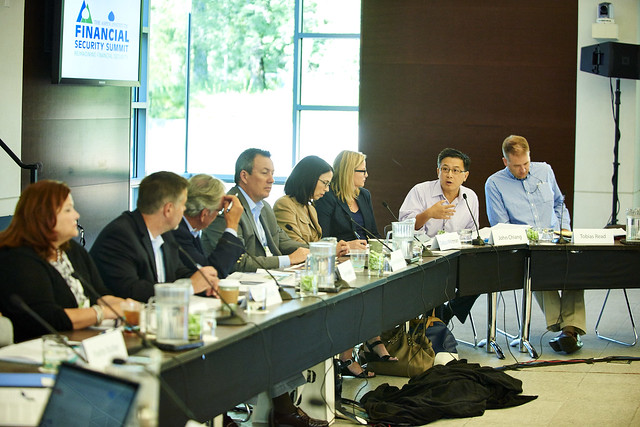The Aspen Initiative on Financial Security held its fourth annual Financial Security Summit in July in Aspen, Colorado. This year, the theme “Reimagining Financial Security: Managing Risk and Building Wealth in an Era of Inequality” served as the catalyst for a two-day dialogue among 45 influential leaders from the investment and banking industry, government, academia and non-profits. Together they grappled with some of the core drivers of financial insecurity and inequality among U.S. households, and searched for common ground on solutions that could improve financial security during working years and in retirement.
*Follow the links below for in-depth descriptions of each panel.
The Summit began the evening of July 15th with an opening event titled, “Pathways to Building Wealth for All Americans.” The panelists spoke on their experiences with research and policy-making in the areas of retirement savings, homeownership, and tax policy, and offered their predictions for how these issues will be framed in the upcoming presidential election. Participants kicked off discussions the next morning with a session on “Converging on a New Vision for Financial Security.” Panelists presented various frames and definitions of financial wellbeing, touching on consumer-based methods of assessing financial wellbeing, demographic drivers of wealth inequality, the employer’s role in achieving financial health, and asset-building as a path to financial security.
In the following panel, participants focused on “The Changing Nature of Work” and its implications for financial security. The panelists identified stagnant wages, the lack of benefits offered for most part-time and contingent jobs, and the lack of employment opportunities in communities of color as significant challenges to achieving financial security. The third session, “Income Volatility and Economic Shocks,” explored the causes behind income and expense volatility, the magnitude and urgency of the problem, and potential market and public policy solutions to both reduce and manage volatility.
Thursday evening, participants gathered for a conversation on “Reconnecting Growth and Prosperity.” The panelists discussed policies such as expanded fiscal spending, financial market reform, and targeted job creation, as well as the political feasibility of these policies. Friday morning, participants took on “Expanding Retirement Savings: Policy and Market Solutions”—a conversation covering state, federal, and market solutions. This comprehensive panel conveyed the urgency of the retirement savings crisis and offered new perspectives and platforms for solutions. The Summit concluded with the panel, “The Future of Financial Innovation, Inclusion, & Shared Prosperity.” This session gave participants a chance to hear about innovations in retirement savings, investing, and asset-building, and to integrate topics and concerns from previous panels.
The expertise and variety of voices at the table, coupled with a deliberate examination of both short and long-term savings issues, created a new and valuable Summit experience. While the conversations revealed some healthy tensions and provided much food for thought, the intensive discussions also brought a congruity of opinion to the forefront. Participants agreed on the need for a holistic view of these issues—to avoid getting “siloed” within one particular topic. Participants also agreed that Americans need more opportunities to save for both the short and long term; that we need to fix what isn’t working (i.e. the tax code) and strengthen what is (i.e. Social Security). Particular attention needs to be paid to redoubling our efforts to fully integrate disadvantaged communities into the economy, to ensure that all families have the opportunity to build wealth and achieve financial security. Participants departed with new connections, new ideas, and a sense of rejuvenation that only a summit in Aspen can bring.


